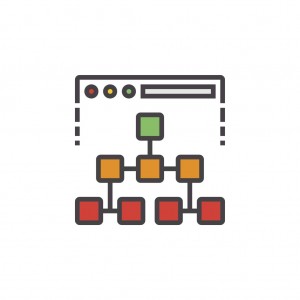Building a sitemap is often one of the first tasks an SEO, web design agency, or webmaster will do when beginning a new SEO campaign or website design project. Many websites will see an increase in traffic and enhanced SEO results after submitting a sitemap to popular search engines like Google and Bing. Therefore, creating a sitemap for your website is an important and relatively simple step that can boost your website’s performance. Keep reading to learn what a sitemap is, why they are important and how to create them!
What Is a Sitemap?
 A sitemap is exactly what its name suggests: a map of all of the pages on your website. Sitemaps are typically arranged in a hierarchical structure. For example, your website’s homepage would likely be the most important and top page on your website. The next most important pages may be category pages or service pages, which are followed by subcategories and individual product pages. Of course, your sitemap will be unique to your business and your website.
A sitemap is exactly what its name suggests: a map of all of the pages on your website. Sitemaps are typically arranged in a hierarchical structure. For example, your website’s homepage would likely be the most important and top page on your website. The next most important pages may be category pages or service pages, which are followed by subcategories and individual product pages. Of course, your sitemap will be unique to your business and your website.
Types of Sitemaps
There are different types of sitemaps used by humans and by search engines. Each has its unique purpose and is important in various steps throughout the web design and SEO process.
Visual Sitemap
A visual sitemap is used during the planning of a website by web designers. It is a literal graphical representation of the pages on the website along with the structure and hierarchical relationship between them. This type of sitemap is nice to have, but is mostly just used when planning or designing a website.
HTML Sitemap
An HTML sitemap is visible by humans and users of a website. It is often found on its own page on a website or in the footer, depending on how large the HTML sitemap is. An HTML sitemap is mostly for users, but it does have some SEO value as well.
HTML sitemaps exist to provide an improved user experience and allow easier navigation of the website. They typically contain links to the most important pages on the website, and they can be used to help users find a particular page they are looking for. By providing a sitemap for users, it could result in them browsing more pages on your website or increasing the amount of time they spend on your website.
In addition to providing a better user experience, HTML sitemaps have some SEO value. Including an HTML sitemap on your website, especially if it is in the footer of every page, increases the amount of internal links on your website. Internal linking is useful because it keeps search engine robots crawling your website longer, which decreases the chance a search engine robot will miss an important page on your website during a crawl.







 WebFX, Inc.
1705 N. Front St.
Harrisburg, PA 17102
WebFX, Inc.
1705 N. Front St.
Harrisburg, PA 17102